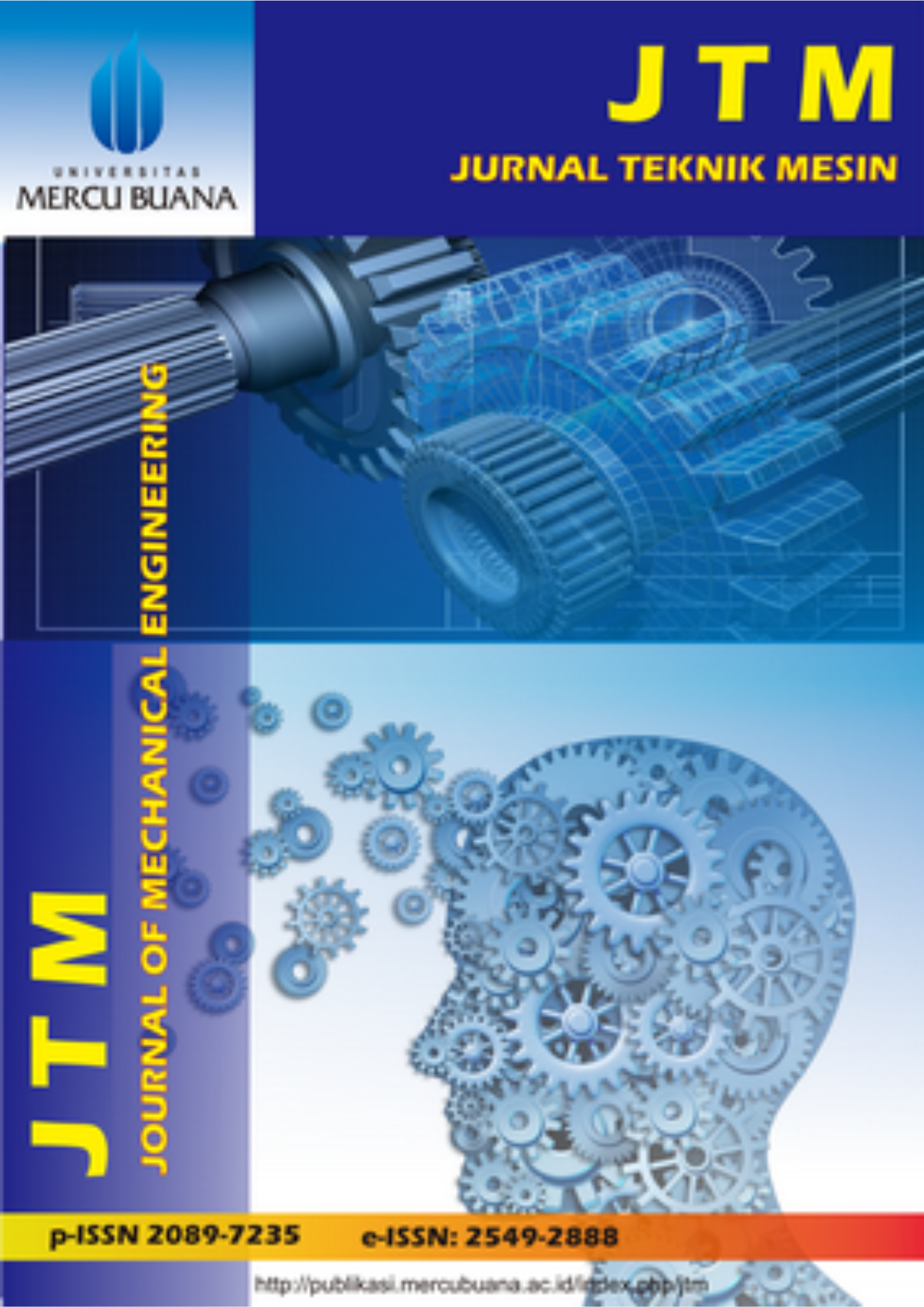Analisis Komparasi Kekuatan Geometri Desain Rusuk Penguat pada Kursi Plastik menggunakan Computer Aided Engineering
Abstract
Keywords
Full Text:
PDF (Bahasa Indonesia)References
D. Romahadi, N. Ruhyat, and L. B. D. Dorion, “Condensor design analysis with Kays and London surface dimensions,” SINERGI, vol. 24, pp. 81–86, 2020, doi: 10.22441/sinergi.2020.2.001.
F. Anggara, D. Romahadi, A. L. Avicenna, and Y. H. Irawan, “Numerical analysis of the vortex flow effect on the thermal-hydraulic performance of spray dryer,” SINERGI, vol. 26, no. 1, pp. 23–30, Feb. 2022, doi: 10.22441/SINERGI.2022.1.004.
A. A. Luthfie, D. Romahadi, H. Ghufron, and S. D. Murtyas, “Numerical simulation on rear spoiler angle of mini MPV car for conducting stability and safety,” SINERGI, vol. 24, no. 1, pp. 23–28, Dec. 2019, doi: 10.22441/SINERGI.2020.1.004.
A. Sutisna, N. A., Aulia, M. F., & Akbar, “FEM Simulation of Electric Car Chassis Design with Torsional Bar Technology FEM Simulation of Electric Car Chassis Design with Torsional Bar Technology,” 2019.
M. F. Ashby, Materials Selection In Mechanical Design, 4th Edition. Burlington: Elsevier Ltd, 2011.
P. Jindal, F. Worcester, F. L. Siena, C. Forbes, M. Juneja, and P. Breedon, “Mechanical behaviour of 3D printed vs thermoformed clear dental aligner materials under non-linear compressive loading using FEM,” J. Mech. Behav. Biomed. Mater., vol. 112, p. 104045, Dec. 2020, doi: 10.1016/J.JMBBM.2020.104045.
M. E. Mohamed, P. Bonello, P. Russhard, P. Procházka, M. L. Mekhalfia, and E. B. T. Tchuisseu, “Experimental validation of FEM-computed stress to tip deflection ratios of aero-engine compressor blade vibration modes and quantification of associated uncertainties,” Mech. Syst. Signal Process., vol. 178, p. 109257, Oct. 2022, doi: 10.1016/J.YMSSP.2022.109257.
F. Klocke et al., “Examples of FEM application in manufacturing technology,” J. Mater. Process. Technol., vol. 120, no. 1–3, pp. 450–457, Jan. 2002, doi: 10.1016/S0924-0136(01)01210-9.
S. Daniele, D. Spaggiari, D. Santoro, P. Cova, and N. Delmonte, “FEM analysis of a HF coreless transformer for automotive applications,” Microelectron. Reliab., vol. 126, p. 114224, Nov. 2021, doi: 10.1016/J.MICROREL.2021.114224.
K. Korus, M. Salamak, and M. Jasiński, “Optimization of geometric parameters of arch bridges using visual programming FEM components and genetic algorithm,” Eng. Struct., vol. 241, p. 112465, Aug. 2021, doi: 10.1016/J.ENGSTRUCT.2021.112465.
Q. Gao, L. Qi, S. Gao, L. Lu, L. Song, and F. Zhang, “A FEM based modeling method for analyzing the static performance of aerostatic thrust bearings considering the fluid-structure interaction,” Tribol. Int., vol. 156, p. 106849, Apr. 2021, doi: 10.1016/J.TRIBOINT.2020.106849.
Z. Xu and W. Xie, “Phase-field model for brittle fracture based on the inner-element edge-based smoothed finite method (IES-FEM),” Eng. Fract. Mech., vol. 254, p. 107919, Sep. 2021, doi: 10.1016/J.ENGFRACMECH.2021.107919.
P. Karban, D. Pánek, T. Orosz, I. Petrášová, and I. Doležel, “FEM based robust design optimization with Agros and Ārtap,” Comput. Math. with Appl., vol. 81, pp. 618–633, Jan. 2021, doi: 10.1016/J.CAMWA.2020.02.010.
W. Sun, W. Lu, F. Bao, and P. Ni, “A PD-FEM coupling approach for modeling thermal fractures in brittle solids,” Theor. Appl. Fract. Mech., vol. 116, p. 103129, Dec. 2021, doi: 10.1016/J.TAFMEC.2021.103129.
A. Putranto, “Redesain dan analisis Finite Element Method Rangka Monocoque Bagian Atas (Top Frame) pada Bus Listrik PT MAB Berbasis Software Inventor,” Unnes Repos. T Technol. TJ Mech. Eng. Mach., 2020.
C. Xiaolin, Finite Element Modeling and Simulation with ANSYS Workbench. London New York: CRC Press, 2014.
J. D. Bethune, Engineering design and graphics with SolidWorks. Macromedia Press, 2019.
R. Mahakul, D. Nath Thatoi, S. Choudhury, and P. Patnaik, “Design and numerical analysis of spur gear using SolidWorks simulation technique,” Mater. Today Proc., vol. 41, pp. 340–346, Jan. 2021, doi: 10.1016/J.MATPR.2020.09.554.
B. Shi, “Abaqus vs . SolidWorks : Dawn of FEA Department of Mechanical Engineering,” Imperial College London, 2021.
K. Vardaan and P. Kumar, “Design, analysis, and optimization of thresher machine flywheel using Solidworks simulation,” Mater. Today Proc., vol. 56, pp. 3651–3655, Jan. 2022, doi: 10.1016/J.MATPR.2021.12.348.
L. Wilis, Puspita Kartika; Hyunsoo, “Simulation Testing On Improved Design Of College Chair Using Finite Element Method,” in eProceedings of Engineering, 2018, pp. 1329–1334.
DOI: http://dx.doi.org/10.22441/jtm.v12i1.16503
Refbacks
- There are currently no refbacks.
Copyright (c) 2023 Jurnal Teknik Mesin
Jurnal Teknik Mesin (JTM)
Program Studi Teknik Mesin, Fakultas Teknik, Universitas Mercu Buana
Jl. Meruya Selatan No. 01, Kembangan, Jakarta Barat 11650, Indonesia
Email: [email protected]
Telp.: 021-5840815/ 021-5840816 (Hunting)
Fax.: 021-5871335
JTM is indexed by the following abstracting and indexing services:

This work is licensed under a Creative Commons Attribution-NonCommercial 4.0 International License.






.png)







_(486_x_90_px)_(486_x_190_px)_(486_x_190_px)_(4).png)
_(486_x_90_px)_(486_x_190_px)_(486_x_190_px)_(5).png)
2.png)
.png)
